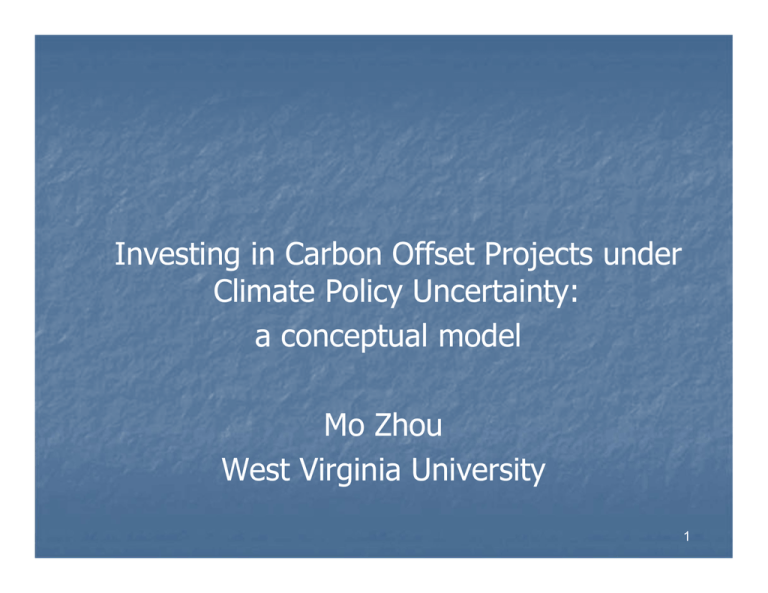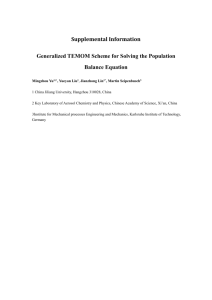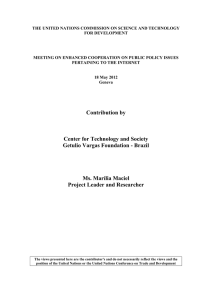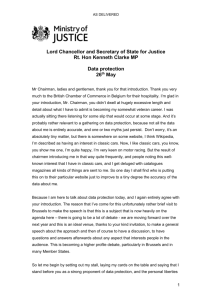Investing in Carbon Offset Projects under Climate Policy Uncertainty: a conceptual model
advertisement

Investing in Carbon Offset Projects under Climate Policy Uncertainty: a conceptual model Mo Zhou West Virginia University 1 In times of climate change Forests offset CO2 through sequestration provide carbon-neutral feedstock for energy production Key: Climate policy - Carbon price - Energy price - Energy policy 2 International Efforts Kyoto Protocol – binding commitments to 5% reduction against 1990 level by 2012 European Union Emission Trading Scheme Market-based mechanisms for mandatory reduction Copenhagen Accord: not legally binding 3 Clear Skies and Global Climate Change Initiative Bush Admin. 2002 policy Goal: 18% reduction of GHG from 2002 to 2012 Incentives for voluntary reduction - Chicago Climate Exchange (2003 -2010) - Regional Greenhouse Gas Initiative (RGGI) 4 Waxman-Markey Climate Change Bill American Clean Energy and Security Act of 2009 (H.R. 2454) Market-based approach to GHG emission reduction: CAP and TRADE Passed by the House on 6/26/09 Yet to be passed by the Senate… Boxer-Kerry bill? 5 Offset credits earned through Afforestation and reforestation Forest conservation Sustainable forest management Offset credits tradable at market price – affected by climate policy 6 Projected/Proposed Carbon Prices ($/tonne of CO2) Council of Economic Advisers $ 20 Empirical models $ 18 ~ 260 Climate change bills Price floor ($10, $11), price ceiling ($28) 7 Modeling Policy Uncertainty through carbon price Dramatic changes due to abrupt policy changes: regime-switching model Regime 1: S1 voluntary reduction Expected carbon price PS1(assumed $5) Regime 2: S2 mandatory reduction Expected carbon price PS2 (uncertain) 8 Transition between regimes Prob Prob Prob Prob (St (St (St (St = = = = 1 2 2 1 | | | | St-1 St-1 St-1 St-1 = = = = 1) 1) 2) 2) = = = = p 1-p q 1-q Starting from regime 1, 1-p reflects uncertainty of Regime change. 9 Baseline: no offset investment fixed timber price Max NPV of timber income Scenarios: options of offset investment fixed timber price uncertain carbon price Max NPV of combined carbon and timber income 10 A simplified stand State Volume (m3 ha-1) Immediate net return ($ ha-1) * 0 0 -494 (planting) 1 29 -117 2 274 3068 3 530 6396 4 728 8970 5 868 10790 For each state, options include doing nothing or cutting. * Assuming a fixed timber price. 11 A linear-programming model max NPV Rik yik i k subject to : y jk k a yik p j i, k j yik 0 i j 1,..., n k i, k where, 1 a (1 r ) D 12 Baseline: Max NPV At a discount rate of 3 percent, starting from state 1, regime 1 NPV* = 8468.3 $ ha-1 State Optimal Decision 0 Plant 1 No Cut 2 No Cut 3 Cut 4 Cut 5 Cut 13 Offset options . State Carbon (t ha-1) 0 0 1 4 2 19 3 36 4 54 5 67 For each state, options include doing nothing, offset, or cutting A fixed offset cost of 200 $ ha-1 was assumed regardless of stand state. 14 Under current carbon price $5/t At a discount rate of 3 percent, starting from state 1 and regime 1: NPV* = 8468.3 $ ha-1 ( equal to baseline) Same optimal decision. Thus, offset investment option has zero value. 15 Carbon price uncertainty Regime 1: S1 voluntary reduction Expected carbon price PS1 $5/t Regime 2: S2 mandatory reduction Expected carbon price PS2 Scenarios: $10, $28, $260 /t 16 Uncertainty of Regime Switch End: S1 Start: S1 S2 Start: S1 S2 S2 0.9End: S 0.1 S 1 2 0.1 0.9 End: S1 0.7 0.3 Start: 0.1 0.9 S1 0.5 S2 Start: 0.1 S1 S2 S2 End:S1 0.5 0.9 S2 0.3 0.7 0.1 0.9 17 Regime 2: price floor 10 $/t Option value of offset investment 600 400 200 0 1 2 Certainty 3 of regime 4 switch r = 3%, starting from state 1 and regime 1 5 6 18 P = 0.9 and q = 0.9 (less certain switch) NPV* = 8,675 $ ha-1 (2% increase) P = 0.1 and q =0.9 (more certain) NPV* = 9,068 $ ha-1 (7% increase) Optimal decision State Regime 1 Regime 2 0 Plant Plant 1 No cut Offset 2 No cut Offset 3 Cut Cut 4 Cut Cut 5 Cut Cut 19 Regime 2: price ceiling 28 $/t 2000 Option value of offset investment 1500 1000 500 0 1 2 3 of regime 4 switch Certainty r = 3%, starting from state 1 and regime 1 5 6 20 P = 0.9 and q = 0.9 (less certain switch) NPV* = 9,145.6 $ ha-1 (8% increase) P = 0.1 and q =0.9 (more certain) NPV* = 10,434 $ ha-1 (23% increase) Optimal decision State Regime 1 Regime 2 0 Plant Plant 1 No cut Offset 2 No cut Offset 3 Cut Cut 4 Cut Cut 5 Cut Cut 21 Regime 2: 260 $/t 40000 Option value of offset investment 30000 20000 10000 Certainty of regime switch 0 1 2 Certainty 3 of regime 4 switch r = 3%, starting from state 1 and regime 1 5 6 22 Optimal decision p = 0.9 and q = 0.9 (less certain switch) NPV* = 21,056 $ ha-1 (149% increase) State Regime 1 Regime 2 0 Plant Plant 1 No cut Offset p = 0.1 and q =0.9 2 Cut Offset (more certain switch) NPV* = 45,380$ ha-1 (436% increase) 3 Cut Offset 4 Cut Cut 5 Cut Cut 23 Conclusion Options of offset investment have no value under current carbon price. Climate policy uncertainty creates significant option values. Option values increase as carbon price increases. Option values increase as regime switch becomes more certain. 24





